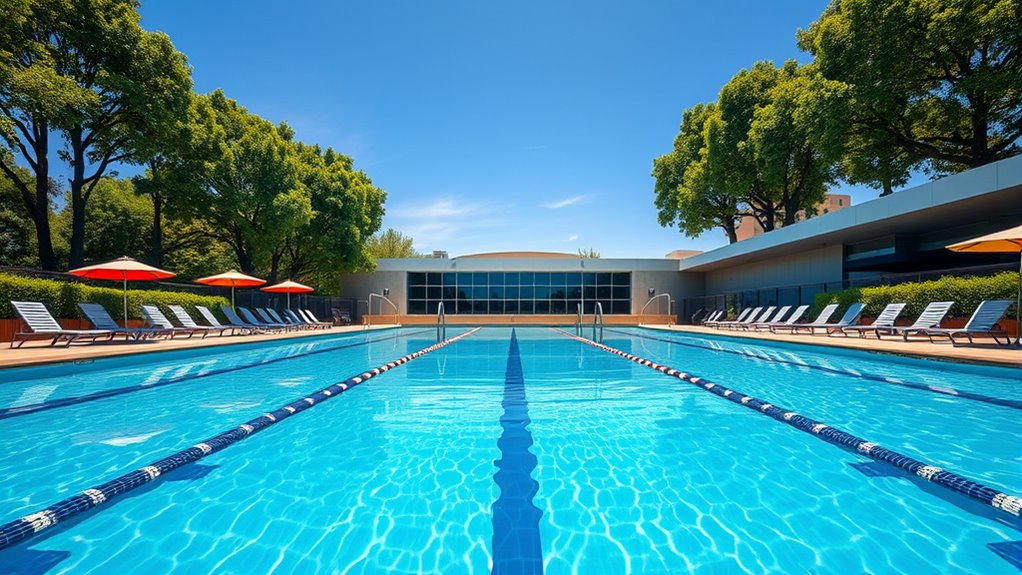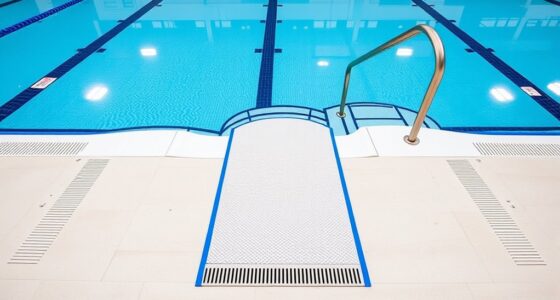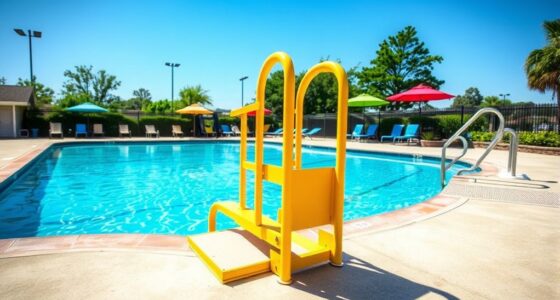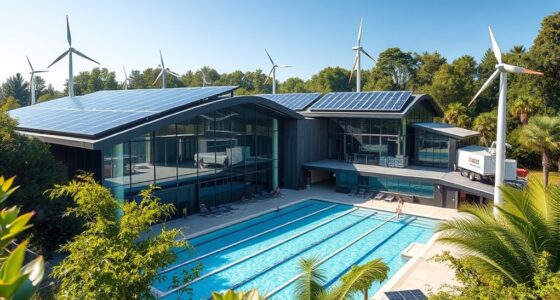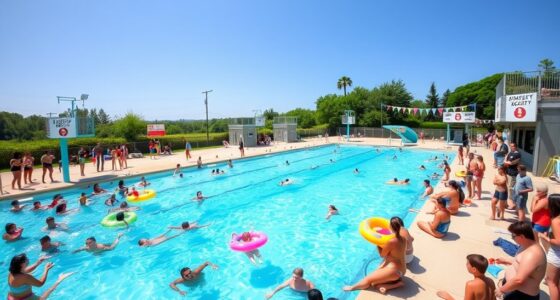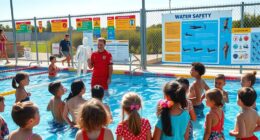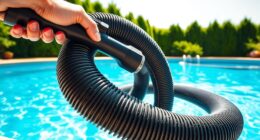To guarantee safety in school and university pools, you should prioritize thorough lifeguard training, regular water quality checks, and clear safety signage. Maintain and inspect equipment routinely, enforce strict safety procedures, and keep safety gear readily accessible. proactive safety management and consistent oversight help prevent accidents and build confidence among swimmers. If you want to discover more ways to create a secure swimming environment, keep exploring proven safety strategies and standards.
Key Takeaways
- Ensure comprehensive lifeguard training with regular refreshers on rescue techniques and safety protocols.
- Maintain strict water quality standards through routine testing and proper filtration systems.
- Use clear signage and enforce safety rules consistently to promote a secure swimming environment.
- Regularly inspect and maintain safety equipment, ensuring accessibility and proper functioning.
- Implement proactive safety management with scheduled audits, safety drills, and continuous staff education.
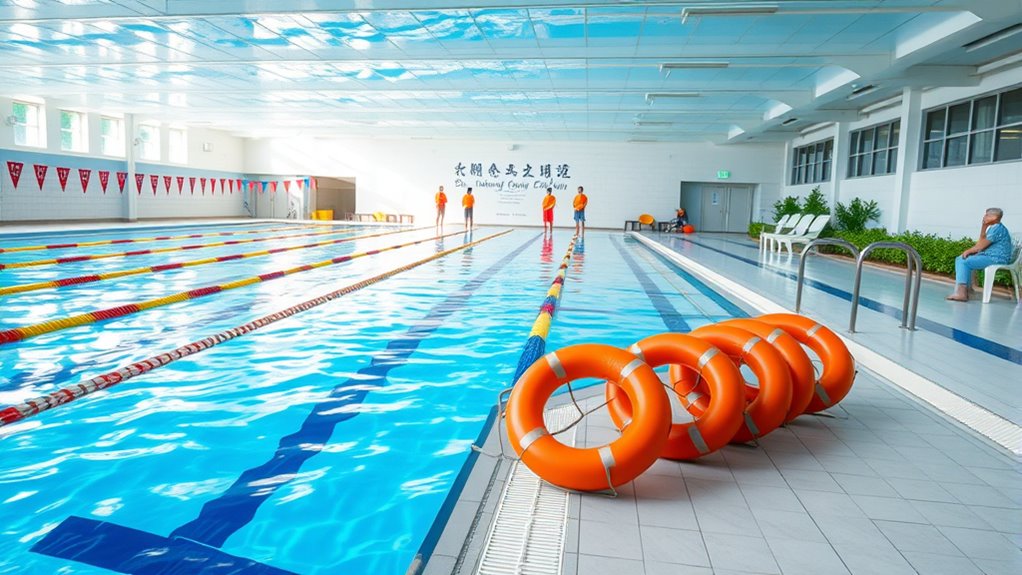
Creating a safe and enjoyable swimming environment in school and university pools requires careful planning and adherence to best practices. One of the most critical aspects of safety is ensuring that your lifeguards are properly trained. Lifeguard training isn’t just about rescuing swimmers in distress; it covers everything from recognizing potential hazards to enforcing pool rules effectively. Well-trained lifeguards understand how to respond swiftly and calmly in emergency situations, minimizing risks and ensuring a secure environment for everyone. Regular refresher courses are crucial, as they keep lifeguards updated on the latest safety protocols and rescue techniques, which can make all the difference in an emergency.
Equally important is diligent pool maintenance. Regular pool maintenance keeps the water clean, safe, and inviting, which encourages students and staff to swim confidently. This includes monitoring water chemistry levels—pH, chlorine, alkalinity—and adjusting them as needed to prevent bacteria growth and skin irritations. Proper filtration and circulation systems are indispensable for maintaining water clarity and preventing the buildup of debris or algae. Routine inspections of pool equipment and plumbing help identify potential issues before they become costly repairs or safety hazards. Additionally, maintaining the pool deck, ladders, and safety equipment like life rings and first aid kits ensures a quick response if an incident occurs.
You should also establish clear safety procedures and enforce them consistently. Signage indicating depth levels, no diving zones, and pool rules should be visible and understandable for all users. Conducting regular safety drills with staff and students reinforces these procedures and keeps everyone prepared. Proper supervision during swim lessons, free swim, or any aquatic activity is fundamental; never leave the pool unsupervised, and ensure that lifeguards are actively monitoring the area at all times. Incorporating vibrational awareness into safety training can further enhance the staff’s ability to recognize signs of distress or unsafe behavior early.
Furthermore, implementing a routine schedule for both pool maintenance and safety checks demonstrates your commitment to a secure environment. Regularly calibrate equipment, clean the filtration systems, and test water quality. Schedule safety audits and review emergency response plans periodically to identify areas for improvement. These proactive measures not only prevent accidents but also foster confidence among students, staff, and visitors that their safety is a top priority.
Frequently Asked Questions
How Often Should Pool Water Quality Be Tested?
You should test your pool water at least 2-3 times a week to guarantee ideal water quality. Regular testing helps you catch imbalances early. When choosing testing equipment, opt for reliable, easy-to-use kits that measure pH, chlorine levels, and other key parameters. Consistent water testing frequency and proper equipment selection keep your pool safe, clean, and compliant with health standards.
What Safety Measures Are Required for Pool Access?
Like the lighthouse guiding ships, proper safety measures guarantee a safe swimming environment. You should install clear pool signage indicating rules, depth markers, and emergency procedures. Make certain a trained lifeguard is always on duty, with current lifeguard training certified in CPR and first aid. These steps help prevent accidents and promote safety, making your pool a secure space where everyone can swim confidently and enjoyably.
How to Handle Pool Emergencies Effectively?
When a pool emergency occurs, you need to act swiftly. Make certain your staff has proper lifeguard training and practice regular emergency drills to stay prepared. Quickly assess the situation, provide immediate assistance if needed, and call emergency services if necessary. Clear communication and calm coordination are vital. Keep safety equipment accessible, follow established emergency procedures, and review responses afterward to improve your pool’s safety protocols continually.
What Are the Maintenance Costs for School Pools?
Think of pool maintenance costs as a steady drumbeat, necessary to keep everything running smoothly. You’ll spend around $2,000 to $5,000 annually on pool cover maintenance and chemical storage safety. Regularly inspecting and cleaning the pool cover prevents damage, while safe chemical storage avoids costly accidents. These expenses guarantee the pool remains safe, clean, and inviting for students, making the investment worthwhile to sustain a well-maintained aquatic space.
How to Ensure Inclusivity for All Students?
You guarantee inclusivity for all students by implementing adaptive accessibility features, like ramps and pool lifts, so everyone can participate comfortably. Offer inclusive programming that caters to diverse abilities, ensuring activities are adaptable and welcoming. Encourage staff training on inclusivity and sensitivity. Regularly gather feedback from students to improve accessibility and programming, creating a supportive environment where every student feels valued and can enjoy the pool safely and confidently.
Conclusion
By following best practices, maintaining safety, and prioritizing cleanliness, you create a welcoming, secure, and enjoyable environment. Regular maintenance, staff training, and clear policies guarantee everyone benefits from the pool. Embrace continuous improvement, foster responsible behavior, and promote a culture of respect. When you commit to these principles, you not only enhance the pool experience but also ensure the well-being, confidence, and satisfaction of all users. Ultimately, safety, cleanliness, and community thrive together.
